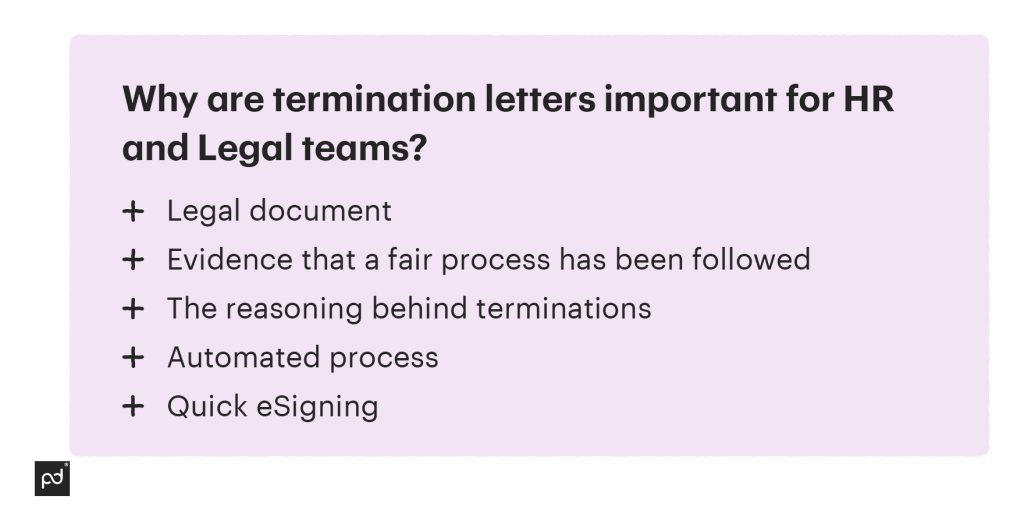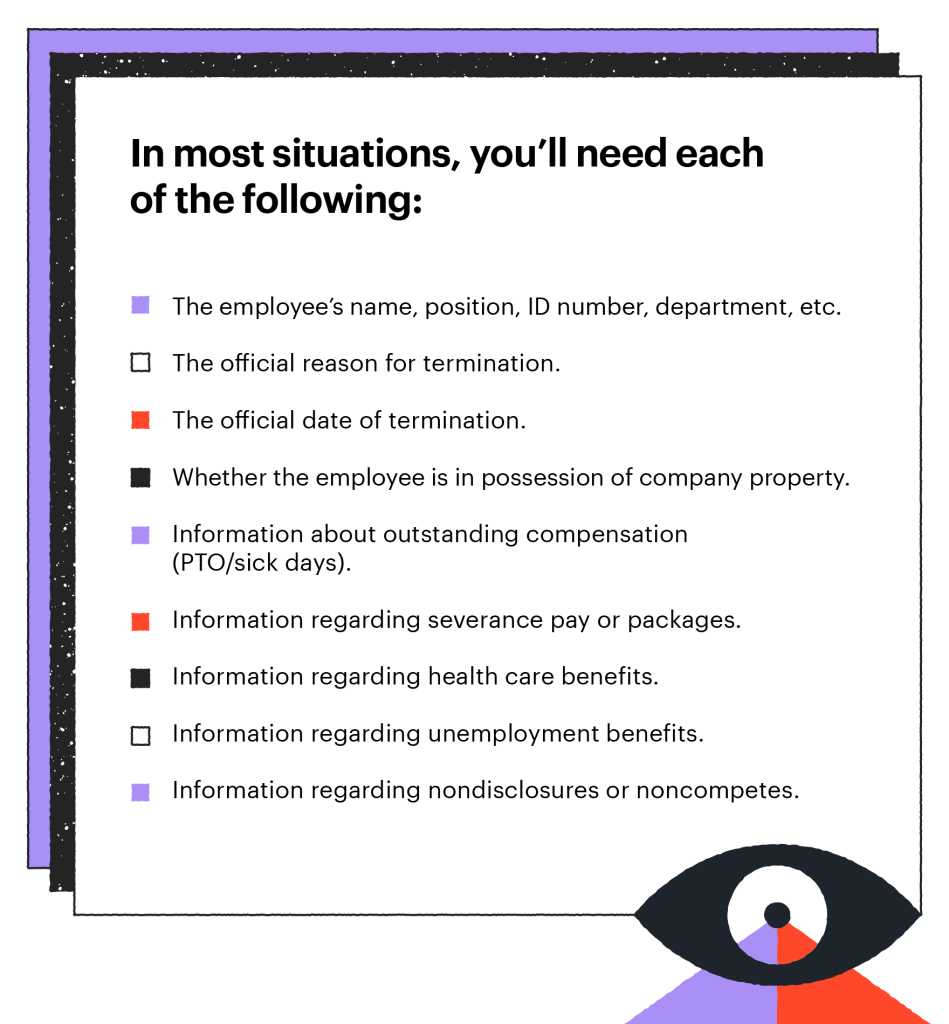Having to write a termination letter to an employee is not a pleasant process, but is often a necessary occurrence in the world of business.
If you find yourself in the position to let someone go, it is important to make sure that you do it in a way that’s both professional and compliant with state and federal laws, and, if circumstances dictate, compassion.
In this blog post, we will examine how to write a termination letter to an employee and give you helpful tips on to make the process as stress free as possible.
What is termination of employment?
Termination of employment means the end of a contract of work between an employer and employee.
It can be a decision taken by either side to end the employment contract, and can be for a number of reasons including redundancies, illness, unacceptable behavior or downsizing.
An employee who is not working due to circumstances such as ill health, leave of absence, or furlough is still officially employed if there has been no formal notice of termination from their manager to end their employment.
What is a letter of termination of employment?
A termination of employment letter is an official termination notice that an employer uses to advise employees of the end of their employment.It is an essential piece of documentation for both HR and legal teams.

A termination notice to an employee in the form of a letter is most often used in situations involving employee misconduct, such as a violation of company policies or the law.
While a letter of termination of employment is usually written by employers to employees, they can also be written by employees who want to voluntarily leave the company (i.e., resignation letters).
Why is notice of termination by letter important?
A termination notice by letter is a written record of the employee’s termination, including the reason for their termination and any other pertinent details.
This letter is important because it provides evidence that your company has acted fairly and legally in terminating an employee.
But there’s more to it than that.
Writing a termination letter is often the last step of an action plan.
These letters can close the loop and demonstrate that an employee was given every opportunity to meet expectations and improve performance before being fired.
This notice of employment termination is also one of the final pieces of documentation that a dismissed employee will receive from your organization.
From that perspective, a termination letter to an employee can outline your company policies surrounding dismissal and provide insight regarding what happens next.
Especially when dismissing senior employees, termination letters may also serve as a soft reminder of NDA, non-compete clauses, and restraint of trade agreements that the employee signed.
For stakeholders, you may also need to discuss a transfer or sale of shares in an official termination letter if these penalties are contractually obligated.
After everything is said and done, a formal letter of termination needs to be kept on file for future access from both HR teams and legal personnel.
Having a tool like PandaDoc in play can help all involved teams store, maintain, and quickly locate any termination letters needed for review.
When are letters used in the termination process?
Typically, a termination letter for an employee is used in conjunction with the closing of a company/employee contract.
It’s one of the most important documents for departing employees since it states the official reason that ended their employment.
Here’s a closer look at the most common scenarios where companies and employees part ways and how termination notice letters play a role.
Voluntary terminations and resignations
Voluntary termination (resignation) is the act of ending employment with an employer.
This differs from involuntary termination because it is initiated by the employee, not the employer, and can be done for a variety of reasons, from better job opportunities to a change in home and family life.
A termination of employment letter won’t be required in these scenarios.
Instead, you’re likely to receive a letter of resignation.
Even so, you should still be prepared to advise employees on the next steps, benefits and compensation, and other considerations that may extend beyond their time with the company.
Keep in mind that resignations can happen without warning and can have a lasting impact on your company.
It’s always best to be prepared and, when possible, have an action plan in place for how to continue operating when employees decide to leave.
Involuntary termination with cause
The most serious (and delicate) of all termination scenarios, involuntary termination means that the company has made the decision to dismiss an employee for specific business reasons.
Termination with cause could take place for a variety of issues, including any of the following reasons:
- Misconduct (on- and off-duty)
- Excessive tardiness or absence
- Failure to follow company policies
- Poor performance
- Harassment or violence
A termination letter to an employee stating those specific reasons will be required in this scenario, and it’s a best practice even if employment is considered “at-will.”
Particularly for terminations surrounding poor performance, involuntary dismissals are often accompanied by other relevant paperwork.
All of this documentation may be relevant and can protect your organization in the case of a wrongful termination suit or similar legal action taken by your former employee.
Layoffs and involuntary termination without cause
Sometimes, companies need to cut costs by reducing staff or relocating their business operations.
As we saw during the coronavirus pandemic, hard financial periods, can also contribute to involuntary employee terminations.
Colloquially, you may know this type of termination by another name: layoffs.
While layoffs can be permanent, as you’d see in the case of a relocation or merger, that isn’t always the case.
Sometimes, these layoffs are temporary in nature because data and forecasting have determined that demand will increase again within a specific period of time, so the company wants staff available to return to work as soon as possible.
This is common if the layoff takes place due to a seasonal lull in business activity.
When layoffs occur, a termination of employment letter will be useful in explaining the official reason for the layoff and for providing any relevant information about when work might resume.
How to write a termination letter to an employee
Writing a termination letter can be difficult, but it is an important part of the process when ending an employment relationship.
In this section, we’ll take a closer look at everything you should include in a typical termination letter.
Please note that this is only a partial guide.
While everything we’ve listed below is appropriate for a termination letter, keep in mind that workers may have rights to health and unemployment benefits that continue after the work relationship is ended.
Your organization is responsible for complying with all labor laws and legal requirements in your specific area, but those obligations may vary depending on local laws and the reason for the termination.
1. Choose your tone carefully
Termination letters are a necessary part of the employee lifecycle.
Whether employees need to be laid off or terminated due to misconduct, it’s important to remember to stay professional and courteous during official communications.
Keep in mind that, if the termination is unexpected, you’ll be cutting an employee’s income, health coverage, and other living essentials while placing them in an uncertain position.
While an employee’s well-being ultimately isn’t the response of the company, you should be aware of these circumstances before you begin the conversation and show compassion where appropriate.
Your termination letter should also help to alleviate some of this uncertainty by providing clear and actionable next steps, where relevant.
2. Gather all necessary details
Before you begin writing a termination letter, take a moment to gather all of the basic information you’ll need to get the job done.

This information will vary for each employee, depending on how long they’ve been with the organization and what responsibilities they have.
In some situations, you may not need everything.
If you’re issuing a notice of termination to a freelancer or contracted employee, termination may be as simple as issuing a notice regarding the last day of employment and giving the contractor enough time to wrap up any outstanding work.
3. Start with basic information
When you begin writing your termination letter, you’ll want to start with the basic information, including the employee’s name and position with the company.
If your organization is large enough, you may also need to list employee ID, their department, and the name of their manager or supervisor.
This information can be contained in a list at the top of the page.
It should be visible, specific, and straightforward to clearly indicate the intended recipient of this information.
Quick note: You can streamline this process using a template, like the termination letter template from the PandaDoc library.

Termination Letter Template
Used 5064 times
Use this Termination Letter when terminating employment for an employee of your company.
Use this template4. Notify the employee of their termination date
The effective date of termination is one of the most important pieces of information.
This should be provided early in the letter to set up clear boundaries around business operations going forward.
In cases where you’re firing someone with cause, termination dates may be the same day the letter is issued, effective immediately.
Other times — especially during layoffs and other scenarios where you don’t have cause to fire someone — you may issue an effective end date well in advance (sometimes months) to give employees time to prepare.
5. State the reason(s) for termination of employment
From the employee’s perspective, the reason for termination is potentially the most critical part of the entire process because it lets them know why they were officially fired.
This section should be clear, honest, and straightforward.
If employees are being fired with cause, you may refer to previous written warnings or months of compiled documentation reflecting poor performance.
More pressing issues, like assault or theft, may also be listed and are considered acceptable reasons for termination.
Here are a few example phrases you might use for this section of your termination later.
“This decision was made due to your failure to meet company guidelines. Specifically, you failed to comply with [rule/regulation/procedure].”
“You were informed on [date] that the company would be switching to new management software that required all employees to learn how to use it, and we offered training opportunities on [dates]. You did not attend any of these sessions and informed us that you were unwilling to use the software or learn how to use it. As a result, we are terminating your employment due to your failure to comply with the requirements of your position.”
“Your employment with us has been wonderful but, as you know, poor profit has forced us to make budget cuts. Unfortunately, this has made it necessary for us to let go of a few staff members. We’re writing to inform you that you are one of the employees that must be let go at this time. Regretfully, we have no choice but to terminate your contract.”
Regardless of the reason for termination, be clear and direct when describing these issues so that the employee understands why they were terminated.
If termination is centered around a specific or ongoing event (such as consistent tardiness), provide clear details regarding that incident.
When issuing this letter (if doing so in person) be prepared to discuss these issues with your outgoing team member, but keep in mind that the decision has already been made.
Regardless of how the employee reacts, you should plan to move forward with termination.
6. Explain compensation and benefits going forward
Even when terminating with cause, outgoing employees will still have some benefits, and you’ll need to include those details as part of your termination letter.
Here’s an example of what this might look like.
“You will not be entitled to receive any severance pay as part of your termination. However, please note that this decision does not in any way affect your access to COBRA benefits, which you may purchase at the rates specified in the continuation coverage election notice that we will send to you within 14 days of today’s date.”
“You will be paid for all of the time and service you have provided up to the date of your termination. You will receive your final paycheck on [final paycheck date]. You will also receive your COBRA notification by mail. If you have any questions about this, please reach out to me.”
“We’ve included a severance package in the amount of [severance package amount] that will be paid to you on [date severance will be paid].”
Companies may issue severance packages alongside a pink slip.
Sometimes, these are circumstantial or contingent upon some kind of NDA. You should be ready to discuss these issues if they come your way.
At the same time, if an employee has accrued paid time off (PTO) or sick leave that’s eligible for payout, be sure to mention it in this section.
For health insurance and health-related benefits, if your company offers COBRA or similar health plans that extend coverage beyond the employment contract, you can detail those benefits here, as well.
It’s also worth noting that many of these benefits and the information that employee receives about them are a standard part of any termination letter.
With that in mind, you might want to build a custom section in a document template using variables so that you can quickly calculate and include precise and relevant information.
Using the example above, you could use a variable like [severange.package.amount] and then simply add the amount into the appropriate field in a PandaDoc template.
This allows for fast and easy personalization with minimal wasted time.
7. Outline next steps and disclaimers
Depending on the nature of the termination, you may need to provide guidance on what should happen next.
In the event of immediate, involuntary termination, security may be standing by to escort a disgruntled employee out of the building.
For terminations worked out over a period of time, you may want to provide a schedule to help employees close out existing contracts, hand over responsibilities to other team members, and depart with minimal team disruptions.
Human resources may have a policy detailing the processes and procedures to follow when establishing timelines for outgoing employees, so be sure to consult existing policies when creating this section.
8. Confirm final details and contact information
Sometimes, a company needs to contact an individual after their termination date.
This can happen if employees fail to return company property or if the company needs to send a final severance check, tax documentation, or similar correspondence by mail.
As part of your termination process, list all relevant contact information (cell phone, home address, etc.) for your employee and ask them to confirm that everything is accurate before they depart.
This will help the business get in touch if there are any outstanding issues.
At the same time, be sure to provide information on who your worker should contact to resolve any outstanding issues.
Keep in mind that regular employee hotlines may not be accessible to former employees and that local numbers may not be the best points of contact going forward.
Termination letter samples to inspire your template
Now that we’ve covered the basics regarding how to write a termination letter, let’s take a closer look at a few examples.
Feel free to adopt this language for your own termination letter templates. Just be sure to adjust the language to fit employee needs.
Termination letter with cause
Jan. 14 20XX
[Employee Name]
[Employee Address]
[Employee Phone]
[Employee Email]
Re: Letter of Termination
Dear [Name],
This letter is to inform you that, effective immediately, your services are no longer required at [COMPANY].
In the past three months, we’ve seen a notable lack in performance. Due to excessive tardiness and a failure to meet performance expectations, we have made the decisions to formally terminate your employment.
Enclosed, you will find a review of our documentation and the disciplinary actions we have taken leading to this decision. You will also find a summary of any severance and/or benefits that are owed to you. These will be issued, along with your final paycheck, on [DATE].
If any of this information is incorrect, or if you wish to discuss the matter further, please contact our team at [NUMBER].
Yours sincerely,
[Name]
[Title]
[Company]
[Contact Information]
Termination of employment without cause
Jan. 14 20XX
[Employee Name]
[Employee Address]
[Employee Phone]
[Employee Email]
Re: Letter of Termination
Dear [Name],
This letter is to inform you that your employment with [COMPANY] will be officially terminated on [FINAL DATE].
Due to the economic downturn, we’ve been forced to downsize dramatically, and your position must be closed. Please complete any outstanding work by [WORKING DATE], and work with your team to hand over any incomplete projects that should continue past your termination date.
Please understand that this is in no way a reflection on your performance, which has been exemplary during your time with us.
Enclosed with this letter, you’ll find our severance offer and a summary list of any benefits that are owed to you. Prior to your departure, confirm that all of your information in your employee file is correct and return any company property.
Thank you again for your hard work. We wish you the best of luck in finding future employment.
Yours sincerely,
[Name]
[Title]
[Company]
[Contact Information]
Termination of a business contract
Jan. 14 20XX
[Employee Name]
[Employee Address]
[Employee Phone]
[Employee Email]
Re: Letter of Termination
Dear [Name],
We regret to inform you that we will not be renewing your employment contract with [COMPANY NAME] this year.
Per the employment agreement you signed at the start of your contract with us, let this letter serve as formal notice that we intend to terminate your employment on [DATE].
Please deliver all outstanding projects prior to your final date.
While this decision did not come lightly, we feel that this was the right choice for the company.
You’ve been an invaluable asset to our team during your time with us, but we’ve decided to move in another direction.
Thanks again for all your hard work, and best of luck with future opportunities!
Yours sincerely,
[Name]
[Title]
[Company]
[Contact Information]
Termination of employment letter templates by PandaDoc simplify the process
And there you have it: everything you need to know about writing the perfect termination letter to employees.
While employment termination letters can be difficult to create, the process can be made much easier by using templates!
Simply create a termination letter that suits your needs, then use the PandaDoc document editor to convert the letter into a document that you can use over and over again.
Not only will this make your business documentation look more formal; it will also speed up the process when you need to generate documentation for your team.
Sign up for a custom demo, and see how PandaDoc can change the way you do business.
Disclaimer
Parties other than PandaDoc may provide products, services, recommendations, or views on PandaDoc’s site (“Third Party Materials”). PandaDoc is not responsible for examining or evaluating such Third Party Materials, and does not provide any warranties relating to the Third Party Materials. Links to such Third Party Materials are for your convenience and does not constitute an endorsement of such Third Party Materials.
Originally was published in June 2022 and has been updated in February 2024


